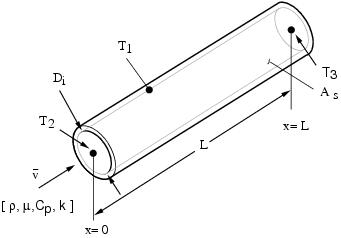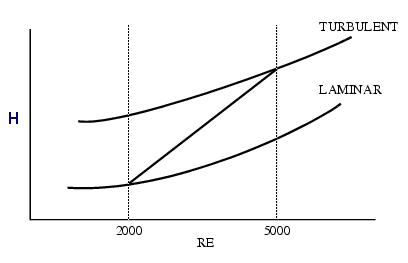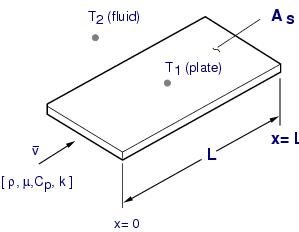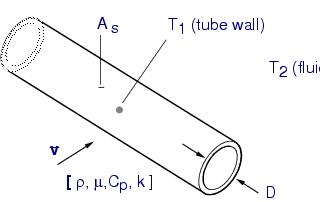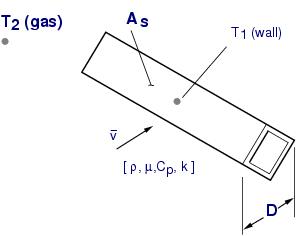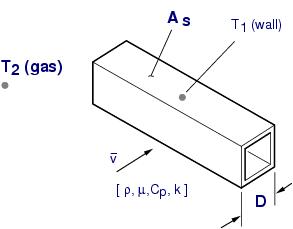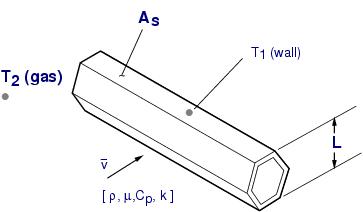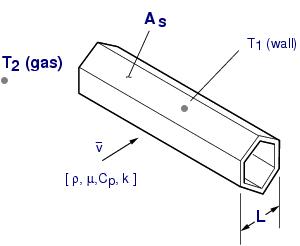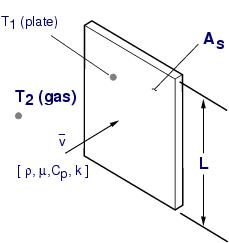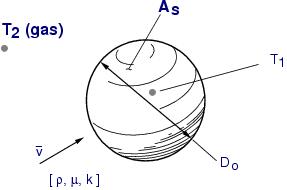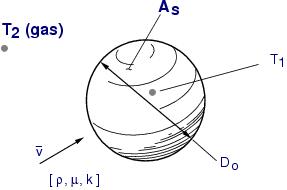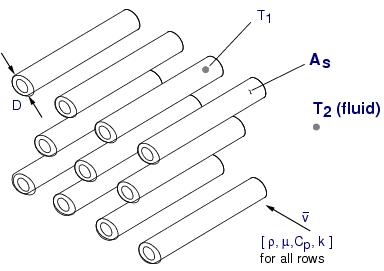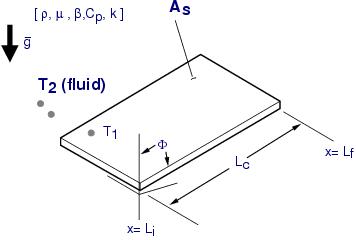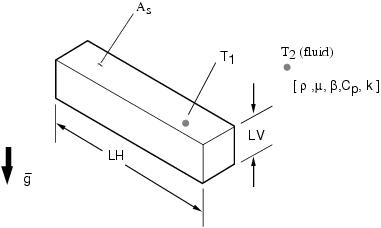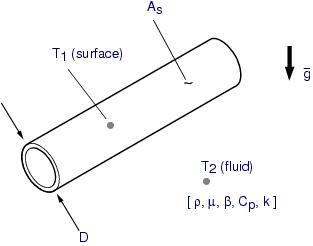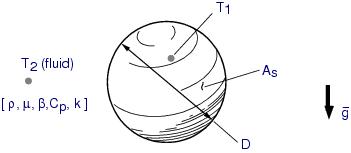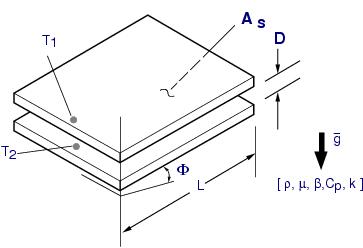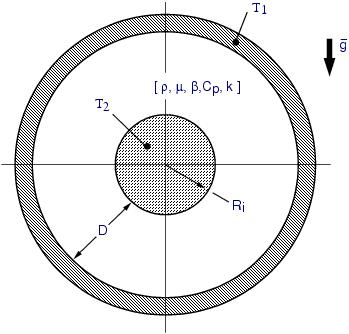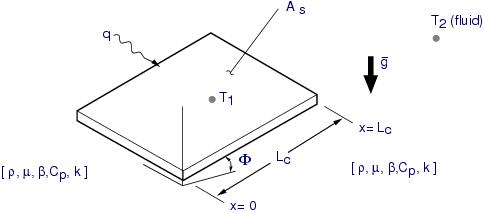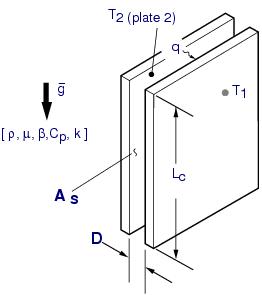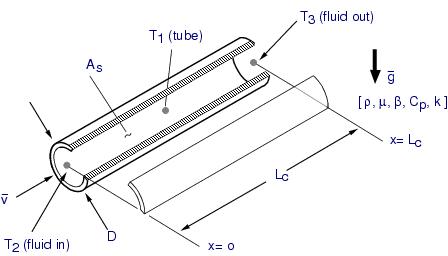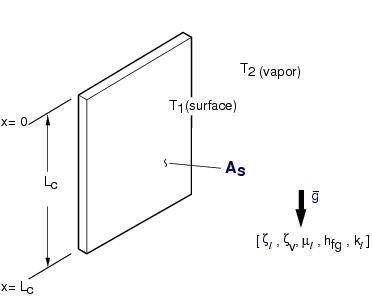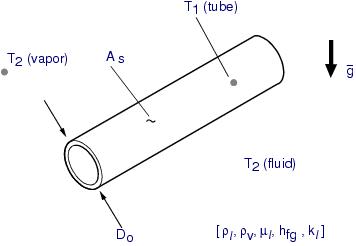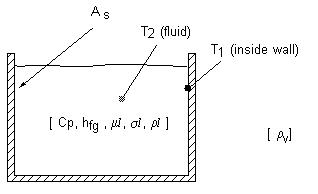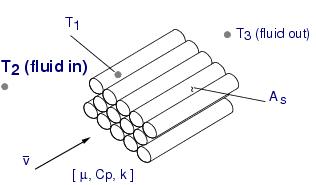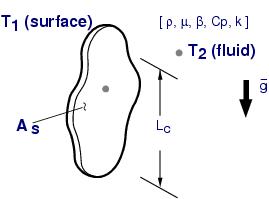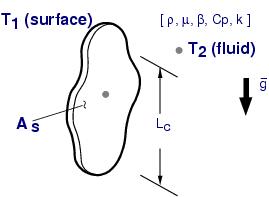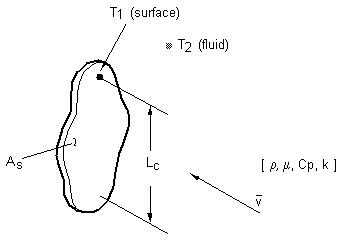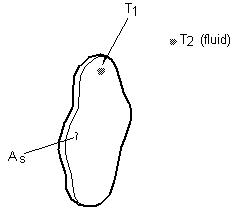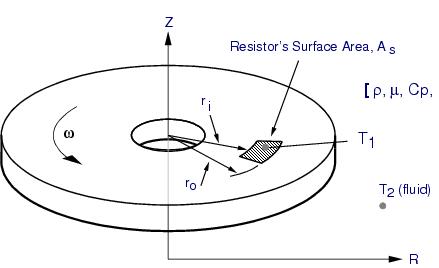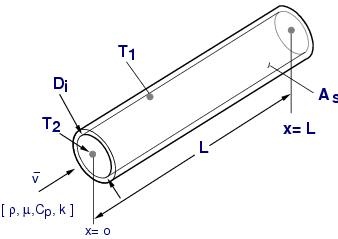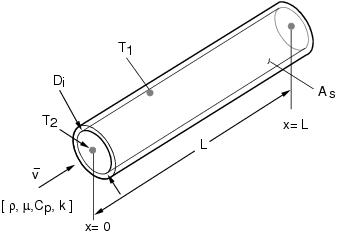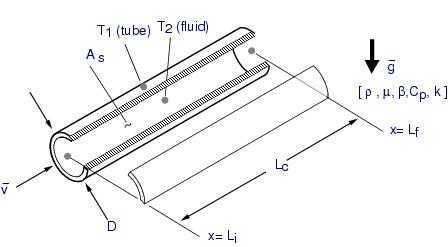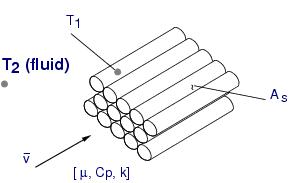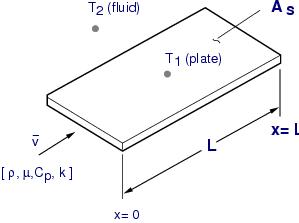XXXXXXXXXXXXXXXXXXXXXXXXXXXXXXXXXXXXXXXXXXXXXXXXXXXXXXXXXXXXXXXXXXXXXXXXXXXXXXXXXXXXXXXXXXXXXXXXXXXXXXXXXXXXXXXXXXXXXXXXXXXXXXXXXXXXXXXXXXXXXXXXXXXXXXXX''"> Convection Configurations
This section is a catalogue of various convection configurations that are available in the QTRAN program. A configuration is defined here to be a given class of convection correlations and not to be confused with Patran element configuration codes. For example, forced convection over flat plates would be one configuration, while natural convection for horizontal cylinders would be another configuration. There are 31 specific configurations and 6 generic configurations currently in the QTRAN library. There are 61 separate convection correlations that are used to support these configurations. When selecting a configuration that is applicable to a given convective resistor, QTRAN automatically selects the appropriate convection correlation for the calculated parameter range (e.g., Rayleigh number ranges, Reynolds number ranges, Prandtl number ranges). If no correlation is available for the calculated parameter range, QTRAN will select the most suitable correlation and print a warning message in the QOUTDAT file. In most cases, QTRAN will not terminate execution. However, for some correlations, such as inclined plates, an erroneous plate angle will cause program termination and an error message. Configurations are selected by specifying the configuration number for the CFIG data entry.
See
Convective Resistor Header Data (Ch. 8).
Most convective resistors will have only two nodes. However, some special resistors (e.g., flow through tubes) require three nodes (i.e., an upstream or entrance node, a downstream or exit node, and a wall node). These are listed explicitly as node numbers in the configuration description.
There are two classes of properties used as input for the convective resistors. The first class of properties are geometric properties (GP). These are properties which are not allowed to be temperature-dependent, and in general are properties such as characteristic lengths, areas, and inclination angles. However, other properties such as gravitational constants are also defined to be GP properties.
MPID numbers (see
MPID Number, Function Type, Temperature Scale, Factor and Label (Ch. 8)) must be specified for the MPID data entry. See
Convective Resistor Material Properties (Ch. 8). The MPID values identify which material properties are to be used for the resistor.
The convection Loads/BC is explained in
Loads and Boundary Conditions Form, 106. The CONV template format (in the TEMPLATEDAT file) which associates the TID specified in the convection LBC, with the convection configuration (CFIG), geometric properties (GPs) and appropriate MPIDs is discussed in
CONV Templates, 700.
Convection correlations are listed with each convective configuration. References for each correlation's source material are provided at the beginning of each correlation's entry.
The following parameter definitions apply to the convection correlations supplied for each convective configuration. More parameter definitions are available with some of the correlations. A listing of the available convection configurations is given below:
Configuration | Description |
| |
| |
| |
| |
| |
| |
| |
| |
| |
| |
| |
| |
| |
| |
| |
| |
| |
| |
| |
| |
| |
| |
| |
| |
| |
| |
| |
| |
| |
| |
| |
| |
| |
| |
| |
| |
| |
| |
| |
| |
| |
| |
| Local Flat Plate Heating, Forced Convection |
| |
| |
Parameter Definitions
Table 9‑1 Symbols
A | = | |
a | = | diffusivity,  |
As | = | surface area. |
Cp | = | constant pressure specific heat. |
CSF | = | |
D | = | diameter. |
EPSI | = | |
g | = | gravitational constant. |
Go | = | |
Gr | = | Grashof number,  |
Gz | = | Graetz number,  |
H | = | convective heat transfer coefficient. |
Hfg | = | enthalpy of phase change. |
k | = | thermal conductivity of fluid. |
Ke | = | equivalent thermal conductivity of convective region. |
L | = | length. |
LMTD | = | log mean temperature difference. |
μm | = | viscosity, usually at free-stream temperature. |
μB | = | viscosity at fluid bulk temperature. |
μf | = | viscosity at film temperature. |
μf  | = | viscosity of liquid. |
μw | = | viscosity, usually at wall temperature. |
Nu | = | Nusselt Number,  |
f | = | angle, in radians. |
Pr | = | Prandtl number,  |
y | = | |
Ra | = | Rayleigh number, Gr Pr. |
Re | = | Reynolds number,  |
ρv | = | density of liquid.  |
ρv | = | density of vapor. |
S | = | |
TB | = | temperature of bulk fluid. |
Tf | = | temperature of film, average of bulk and wall |
Tw | = | temperature of wall. |
ΔTo | = | T1 - T2 |
ΔTL | = | T1 - T3 |
Configuration 1
Forced Convection, Smooth Isothermal Tubes
Node Number | 1 | = | tube/element inside wall temperature,  . |
| 2 | = | fluid entrance temperature,  . |
| 3 | = | fluid exit temperature,  . |
GP | 1 | = | tube/element inside surface area,  . |
| 2 | = | distance from upstream tube/element section to the tube inlet,  . |
| 3 | = | distance from downstream tube/element section to the tube inlet,  . |
| 4 | = | tube/element inside diameter,  . |
| 5 | = | average fluid velocity,  . |
MPID | 1 | = | fluid density,  . |
| 2 | = | fluid absolute viscosity,  . |
| 3 | = | fluid specific heat,  . |
| 4 | = | fluid thermal conductivity, k. |
Figure 9‑1
Correlations for Configuration 1
Evaluate properties at arithmetic mean bulk temperature, except for

which is evaluated at the wall temperature. Use LMTD for calculation of “Q”.
[

Evaluate properties at arithmetic mean bulk temperature, except for μw which is evaluated at the wall temperature. Use LMTD for calculation of “Q”.
Correlation 3
Smooth Isothermal Tubes, Laminar Flow (Ref. 6 in Appendix A)
Re < 2000
Evaluate properties at arithmetic mean bulk temperature. Use LMTD to calculate “Q”.
Use LMTD to calculate “Q”.
Correlation 5
Smooth Isothermal Tubes, Turbulent Flow (Ref. 6 in Appendix A)
This equation will be used when other smooth tube, constant wall temperature correlations are out of their respective Pr and tl number ranges (i.e., 0.05 < Pr < 2.0).
Evaluate properties at mean bulk temperature, with the exception of the wall viscosity. Use LMTD to calculate “Q”.
Transitional Region
For Reynolds numbers between 2000 and 5000, a linear interpolation between the laminar and turbulent functions is used.
Configuration 2
Smooth Tubes, Constant Heat Flux, Forced Convection
Node Number | 1 | = | tube/element inside wall temperature,  . |
| 2 | = | fluid entrance temperature,  . |
| 3 | = | fluid exit temperature,  . |
GP | 1 | = | tube/element inside surface area,  . |
| 2 | = | distance from upstream tube/element section to the tube inlet,  . |
| 3 | = | distance from downstream tube/element section to the tube inlet,  . |
| 4 | = | tube/element inside diameter,  . |
| 5 | = | average fluid velocity,  . |
MPID | 1 | = | fluid density,  . |
| 2 | = | fluid absolute viscosity,  . |
| 3 | = | fluid specific heat,  . |
| 4 | = | fluid thermal conductivity, k. |
Figure 9‑2
Correlations for Configuration 2
Correlation 7
Smooth Tubes, Turbulent Flow, Constant Heat Flux (Ref. 6 in Appendix A)
Evaluate properties at arithmetic mean bulk temperature. Use LMTD to calculate “Q”.
Correlation 8
Smooth Tubes, Laminar Flow, Constant Heat Flux (Rohsenow & Hartnett, Handbook of Heat Transfer)
Properties are evaluated at arithmetic mean bulk temperature. The h value returned will be an integrated average of the H values along the tube length. Four sample points will be taken, and an averaging scheme analogous to Simpson’s 3/8ths rule for integration will then be used. Use the LMTD to calculate “Q”.
X1 is the distance between the upstream end of the tube section and the tube entrance. X2 is the distance between the downstream end of the tube section and the tube entrance. DXP is one third the length of the tube section being modeled.
Compute the x-value distances at four sample points. For consistency, the 4 “X” values will be stored in “XPLUS” variables, i.e. (XPLUS1, XPLUS2, XPLUS3, and XPLUS4). XPLUS1 will be the distance between the tube entrance and the upstream end of the tube section. XPLUS4 is the distance between the tube entrance and the downstream end of this tube section. XPLUS2 and XPLUS3 are spaced evenly so as to divide the tube section being modeled into thirds. Subroutine NUSLT8 will then convert these distances into the XPLUS values as used in Rohsenow and Hartnett.
XPLUS1 = X1
XPLUS4 = X2
XPLUS2 = XPLUS1 + DXP
XPLUS3 = XPLUS2 + DXP
Compute the h values at the (4) sample points along the tube length.
CALL NUSLT8(H1, K, D, XPLUS1, Re, Pr)
CALL NUSLT8(H2, K, D, XPLUS2, Re, Pr)
CALL NUSLT8(H3, K, D, XPLUS3, Re, Pr)
CALL NUSLT8(H4, K, D, XPLUS4, Re, Pr)
Use a weighted average of the H values along the tube length. The weighting scheme is that used for Simpson’s 3/8ths rule for integrating ordinary differential equations.
Configuration 3
Flat Plates, Forced Convection
Node Number | 1 | = | plate/element surface temperature,  . |
| 2 | = | free-stream fluid temperature,  . |
GP | 1 | = | plate/element surface area,  /element. |
| 2 | = | shortest distance from the plate/element’s surface area to the plate’s leading edge,  . |
| 3 | = | longest distance from the plate/element’s surface area to the plate’s leading edge,  . |
| 4 | = | free-stream fluid velocity,  . |
MPID | 1 | = | fluid density,  . |
| 2 | = | fluid absolute viscosity,  . |
| 3 | = | fluid specific heat,  . |
| 4 | = | fluid thermal conductivity, k. |
Figure 9‑3
Correlations for Configuration 3
Reynolds number is based on plate length. Use

to calculate “Q”.
Correlation 10
Flat Plate Forced Convection, Turbulent Flow (Ref. 6 in Appendix A)
2.0E+05 < Re < 5.5E+6
0.7 < Pr < 380.0
Use for “small” temperature differences. Reynolds number is based on plate length. Use

to calculate “Q”. Properties are calculated at free stream temperature.
Configuration 4
Circular Tube in Cross Flow, Forced Convection
Node Number | 1 | = | tube outside wall temperature,  . |
| 2 | = | fluid free-stream temperature,  . |
GP | 1 | = | tube/outside surface area,  . |
| 2 | = | tube/outside diameter, D. |
| 3 | = | fluid free-stream velocity,  . |
MPID | 1 | = | fluid density,  . |
| 2 | = | fluid absolute viscosity,  . |
| 3 | = | fluid specific heat,  . |
| 4 | = | fluid thermal conductivity, k. |
Figure 9‑4
Correlations for Configuration 4
Reynolds number based upon tube diameter. Used for both gases and liquids.
Correlation 12
Circular Tube in Cross Flow, Forced Convection (Ref. 6 in Appendix A)
Reynolds number based upon tube diameter. All properties based upon film temperature unless otherwise noted. Used for both gases and liquids.
Correlation 13
Circular Tube in Cross Flow, Forced Convection (Ref. 6 in Appendix A)
Reynolds number based upon tube diameter. All properties based upon film temperature unless otherwise noted. Used for both gases and liquids.
Reynolds number based upon tube diameter. All properties based upon film temperature unless otherwise noted. Used for both gases and liquids.
Correlation 15
Circular Tube in Cross Flow, Forced Convection (Ref. 6 in Appendix A)
Reynolds number based upon tube diameter. All properties based upon film temperature unless otherwise noted. Used for both gases and liquids.
Configuration 5
Square Tube in Cross Flow, Stagnation Point at Tube Corner, Gas Only, Forced Convection
Node Number | 1 | = | tube outside wall temperature,  . |
| 2 | = | gas free-stream temperature,  . |
GP | 1 | = | tubes outside surface area,  . |
| 2 | = | length of square tube's diagonal, D. |
| 3 | = | gas free-stream velocity,  . |
MPID | 1 | = | gas density,  . |
| 2 | = | gas absolute viscosity,  . |
| 3 | = | gas specific heat,  . |
| 4 | = | gas thermal conductivity, k. |
Figure 9‑5
Correlations for Configuration 5
(5.0E+03 < Re < 1.0E+05)
Reynolds number based on length of square’s diagonal. All properties based upon film temperature unless otherwise noted. Used for gases only.
Configuration 6
Square Tube, Cross Flow, Stagnation Point at Mid-Side, Gas Only, Forced Convection
Node Number | 1 | = | tube outside wall temperature,  . |
| 2 | = | gas free-stream temperature,  . |
GP | 1 | = | tubes outside surface area,  . |
| 2 | = | length of one side of tube’s square, D. |
| 3 | = | gas free-stream velocity,  . |
MPID | 1 | = | gas density,  . |
| 2 | = | gas absolute viscosity,  . |
| 3 | = | gas specific heat,  . |
| 4 | = | gas thermal conductivity, k. |
Figure 9‑6
Correlations for Configuration 6
Correlation 17
Square Tube in Cross Flow, Stagnation Point at Mid-Side, Forced Convection
(Ref. 6 in Appendix A) (5.0E+03 < Re < 1.0E+05)
Reynolds number based upon length of one side of square. All properties based upon film temperature unless otherwise noted. Used for gases only.
Configuration 7
Hexagonal Tube, Cross Flow, Stagnation Point at Edge, Gas Only, Forced Convection
Node Number | 1 | = | tube outside tube wall temperature,  . |
| 2 | = | gas free-stream temperature,  . |
GP | 1 | = | tubes outside surface area,  . |
| 2 | = | distance between parallel sides, L. |
| 3 | = | gas free-stream velocity,  . |
MPID | 1 | = | gas density,  . |
| 2 | = | gas absolute viscosity,  . |
| 3 | = | gas specific heat,  . |
| 4 | = | gas thermal conductivity, k. |
Figure 9‑7
Correlations for Configuration 7
Correlation 18
Hexagonal Tube in Cross Flow, Stagnation Point at Edge, Forced Convection
(Ref. 6 in Appendix A)(5.0E+03 < Re < 1.0E+05)
Reynolds number based on distance between parallel sides. All properties based upon film temperature unless otherwise noted. Used for gases only.
Configuration 8
Hexagonal Tube, Cross Flow, Stagnation Point at Mid-Side, Gas Only, Forced Convection
Node Number | 1 | = | tube outside wall temperature,  . |
| 2 | = | gas free-stream temperature,  . |
GP | 1 | = | tubes outside surface area,  . |
| 2 | = | distance between parallel sides, L. |
| 3 | = | gas free-stream velocity,  . |
MPID | 1 | = | gas density,  . |
| 2 | = | gas absolute viscosity,  . |
| 3 | = | gas specific heat,  . |
| 4 | = | gas thermal conductivity, k. |
Figure 9‑8
Correlations for Configuration 8
(5.0E+03 < Re < 1.95E+04)
Reynolds number based on distance between parallel sides. All properties based upon film temperature unless otherwise noted. Used for gases only.
Correlation 20
Hexagonal Tube in Cross Flow, Stagnation Point on One Side, Forced Convection (Ref. 6 in Appendix A)
(1.95E+04 < Re < 1.0E+05)
Reynolds number based on distance between parallel sides. All properties based upon film temperature unless otherwise noted. Used for gases only.
Configuration 9
Vertical Plate in Horizontal Flow, Gas Only, Forced Convection
Node Number | 1 | = | plate surface temperature,  . |
| 2 | = | gas free-stream temperature,  . |
GP | 1 | = | plate/element surface area,  . |
| 2 | = | shortest distance from element to plate’s edge,  . |
| 3 | = | longest distance from element to plate’s edge,  . |
| 4 | = | gas free-stream velocity,  . |
MPID | 1 | = | gas density,  . |
| 2 | = | gas absolute viscosity,  . |
| 3 | = | gas specific heat,  . |
| 4 | = | gas thermal conductivity, k. |
Figure 9‑9
Correlations for Configuration 9
(4.0E+03 < Re < 1.5E+04)
Reynolds number based on height of plate. All properties based upon film temperature unless otherwise noted. Used for gases only.
Configuration 10
Flow Around a Sphere, Gas Only, Forced Convection
Node Number | 1 | = | sphere wall temperature,  . |
| 2 | = | gas free-stream temperature,  . |
GP | 1 | = | sphere’s surface area,  . |
| 2 | = | sphere diameter,  . |
| 3 | = | gas free-stream velocity,  . |
MPID | 1 | = | gas density, .  |
| 2 | = | gas absolute viscosity,  . |
| 3 | = | gas thermal conductivity, k. |
Figure 9‑10
Correlations for Configuration 10
(17.0 < Re < 7.0E+05)
Reynolds number based upon sphere diameter. All properties based upon film temperature unless otherwise noted. Used for gases only.
Configuration 11
Flow Around a Sphere, Oil and Water Only, Forced Convection
Node Number | 1 | = | sphere wall temperature,  . |
| 2 | = | fluid free-stream temperature,  . |
GP | 1 | = | sphere’s surface area,  . |
| 2 | = | sphere diameter,  . |
| 3 | = | fluid free-stream velocity,  . |
MPID | 1 | = | fluid density,  . |
| 2 | = | fluid absolute viscosity,  . |
| 3 | = | fluid specific heat,  . |
| 4 | = | fluid thermal conductivity, k. |
Figure 9‑11
Correlations for Configuration 11
(1.0 < Re < 2.0E+05)
Reynolds number based upon sphere diameter. All properties based upon film temperature unless otherwise noted. Used for oil and water only. μw is the viscosity evaluated at the wall temperature.
Configuration 12
Staggered Tube Banks Consisting of Ten or More Rows, Single Phase Flow, Forced Convection
Node Number | 1 | = | tube wall temperatures, T. |
| 2 | = | fluid free-stream temperatures,  . |
GP | 1 | = | tube's elements outside surface area,  . |
| 2 | = | tube outside diameter, D. |
| 3 | = | fluid free-stream velocity,  . |
| 4 | = | void fraction (area of flow with tubes divided by area of flow without tubes). |
MPID | 1 | = | fluid density,  . |
| 2 | = | fluid absolute viscosity,  . |
| 3 | = | fluid specific heat,  . |
| 4 | = | fluid thermal conductivity, k. |
Figure 9‑12
Correlations for Configuration 12
Correlation 24
Staggered Tube Banks Consisting of Ten or More Rows, Single Phase Flow, Forced Convection
(Ref. 6 in Appendix A)100.0 < Re < 1.0E+05
0.7 < Pr < 760.0
EPSI < 0.65
EPSI = void fraction (area of flow with tubes/area of flow without tubes)
UAVERAGE = average fluid velocity
Fluid properties evaluated at bulk mean temperature.

= viscosity of the fluid at the wall temperature
Configuration 13
Isothermal Vertical, Horizontal, or Inclined Flat Plates, Natural Convection
Node Number | 1 | = | plate surface temperature,  . |
| 2 | = | fluid temperature,  . |
GP | 1 | = | plate/element's surface area,  . |
| 2 | = | for vertical or inclined plates, shortest distance between the plate/element’s surface area and the plate’s edge where the boundary layer thickness is zero. For example, on a heated vertical plate exposed to a relatively cooler gas, the buoyancy driven convective flow will be upward and hence the boundary layer is of zero thickness at the plate’s bottom edge. You would then enter the shortest distance between the plate/elements area and the bottom edge of the plate,  . For horizontal plates, this value is the surface area divided by the plate perimeter. |
| 3 | = | ignored for horizontal plates. For vertical and inclined plates, this is the longest distance to the plate’s edge where the boundary layer thickness is zero,  . |
| 4 | = | plate inclination angle PHI in degrees.  implies the plate is vertical.  implies the plate is horizontal and facing upward.  implies the plate is horizontal and facing downward.  must be between -90 and +90. The only correlation in the library for inclined plate is for the hot surfaces down or cold surfaces up. |
| 5 | = | gravitational constant,  . |
MPID | 1 | = | fluid density,  . |
| 2 | = | fluid absolute viscosity,  . |
| 3 | = | fluid coefficient of thermal expansion,  . |
| 4 | = | fluid specific heat,  . |
| 5 | = | fluid thermal conductivity, k. |
Figure 9‑13
Correlations for Configuration 13
Ra < 1.0E+09
Rayleigh number based upon plate height.
All properties based upon film temperature.
Correlation 26
Isothermal Vertical Plates, Natural Convection (Ref. 6 in Appendix A)
1.E+09 < Ra
Rayleigh number based upon plate height.
All properties based upon film temperature.
2.6E+04 < Ra < 1.0E+07
L = surface area / perimeter
All properties based upon film temperature.
Correlation 28
Hot Horizontal Plate Facing Upward (or Cold Horizontal Plate Facing Downward), Natural Convection (Ref. 6 in Appendix A)
1.0E+07 < Ra < 3.0E+10
L = surface area / perimeter
All properties based upon film temperature.
Correlation 29
Hot Horizontal Plate Facing Downward (or Cold Horizontal Plate Facing Upward), Natural Convection (Ref. 6 in Appendix A)
3.0E+05 < Ra < 3.0E+10
L = surface area / perimeter
All properties based upon film temperature.
L = plate length

= angle of plate inclination from the vertical
All properties based upon film temperature. For laminar regions, use correlations
(Ref. 6 in Appendix A). Extend correlation using the vertical surface correlations
(Ref. 14 in Appendix A).
Note: the first if statement below should be put with the above equation and then everything lined up and this statement deleted. I don’t know how to do that.
Configuration 14
Rectangular Blocks, Natural Convection
Node Number | 1 | = | block surface temperature,  . |
| 2 | = | fluid temperature,  . |
| | | |
GP | 1 | = | block’s surface area,  . |
| 2 | = | gravitational constant,  . |
| 3 | = | characteristic length L, where: L = F(LH * LV,LH + LV)
and:
LH = the longer of the two horizontal dimensions.
LV = the vertical dimension. |
MPID | 1 | = | fluid density,  . |
| 2 | = | fluid absolute viscosity,  . |
| 3 | = | fluid coefficient of thermal expansion,  . |
| 4 | = | fluid specific heat,  . |
| 5 | = | fluid thermal conductivity, k. |
Figure 9‑14
Correlations for Configuration 14
1.0E+04 < Ra < 1.0E+09
LH = the longer of the two horizontal dimensions.
LV = the vertical dimension.
All properties based upon film temperature.
Configuration 15
Horizontal Cylinders, Natural Convection
Node Number | 1 | = | cylinder outside surface temperature,  . |
| 2 | = | fluid free-stream temperature,  . |
GP | 1 | = | cylinder’s outside surface area,  . |
| 2 | = | gravitational constant,  . |
| 3 | = | cylinder outside diameter, D. |
MPID | 1 | = | fluid density,  . |
| 2 | = | fluid absolute viscosity,  . |
| 3 | = | fluid coefficient of thermal expansion,  . |
| 4 | = | fluid specific heat,  . |
| 5 | = | fluid thermal conductivity, k. |
Figure 9‑15
Correlations for Configuration 15
1.0E+04 < Ra < 1.0E+09
D = cylinder diameter
All properties based upon film temperature.
Correlation 33
Horizontal Cylinders, Natural Convection (Ref. 6 in Appendix A)
1.0E+09 < Ra < 1.0E+12
D = cylinder diameter
All properties based upon film temperature.
Configuration 16
Sphere, Natural Convection
Node Number | 1 | = | sphere surface temperature,  . |
| 2 | = | fluid free-stream temperature,  . |
GP | 1 | = | sphere’s surface area,  . |
| 2 | = | gravitational constant,  . |
| 3 | = | sphere diameter, D. |
MPID | 1 | = | fluid density,  . |
| 2 | = | fluid absolute viscosity,  . |
| 3 | = | fluid coefficient of thermal expansion,  . |
| 4 | = | fluid specific heat,  . |
| 5 | = | fluid thermal conductivity, k. |
Figure 9‑16
Correlations for Configuration 16
1.0E+00 < Ra < 1.0E+05
D. = sphere diameter
All properties based upon film temperature.
Configuration 17
Enclosed Spaces Between Flat Plates, Natural Convection
Node Number | 1 | = | top plate, low or surface temperature,  . |
| 2 | = | bottom plate, upper surface temperature,  . |
GP | 1 | = | plate/element’s surface area that is exposed to the enclosed space,  . |
| 2 | = | enclosed space inclination angle PHI in degrees.  implies that the enclosed space is horizontal.  implies that the space is vertical. |
| 3 | = | gravitational constant,  . |
| 4 | = | length of the enclosed space, L. |
| 5 | = | distance between the flat plates, D. |
MPID | 1 | = | fluid density,  . |
| 2 | = | fluid absolute viscosity,  . |
| 3 | = | fluid coefficient of thermal expansion,  . |
| 4 | = | fluid specific heat,  . |
| 5 | = | fluid thermal conductivity, k. |
Figure 9‑17
Correlations for Configuration 17
2.0E+04 < Gr < 2.0E+05
L = plate height
D = space between plates (normal distance)
Gr number based upon D
All properties based upon average of surface temperatures.
2.0E+05 < Gr < 1.1E+07
L = plate height
D = space between plates (normal distance)
Gr number based upon D
All properties based upon average of surface temperatures.
6.0E+06 < Ra < 1.0E+08
D = space between plates (normal distance)
Ra number based upon D
All properties based upon average of surface temperatures.
Correlation 38
Enclosed Horizontal Space, Natural Convection, Cold Plate on Bottom, Hot Plate on Top, (Ref. 6 in Appendix A)
0 < Gr < 2000
All proprieties based upon average of surface temperatures.
0.0 < φ < 90.0
1.0E+03 < Ra < 1.0E+06
2.0E+04 < Gr < 2.0E+05

= angle inclined from the horizontal.
Ra number based on D.
Gr number based on D.
D = distance between plates.
L = length of plates.
All properties based upon average of plate temperatures.
0.0 < Ra < 1.0E+06
2.0E+05 < Gr < 1.1E+07

= angle inclined from the horizontal.
Ra number based on D.
Gr number based on D.
D = distance between plates.
L = length of plates.
All properties based upon average of plate temperatures.
Configuration 18
Annular Space Between Concentric Spheres, Natural Convection
Node Number | 1 | = | outer sphere surface temperature,  . |
| 2 | = | inner sphere surface temperature,  . |
GP | 1 | = | surface area, of inner diameter of larger sphere,  . |
| 2 | = | radius at the location of the resistor surface area. |
| 3 | = | gap (distance between spheres), D. |
| 4 | = | radius of the inner sphere,  . |
| 5 | = | gravitational constant,  . |
MPID | 1 | = | fluid density,  . |
| 2 | = | fluid absolute viscosity,  . |
| 3 | = | fluid coefficient of thermal expansion,  . |
| 4 | = | fluid specific heat,  . |
| 5 | = | fluid thermal conductivity, k. |
Figure 9‑18
Correlations for Configuration 18
1.2E+02 < Ra < 1.1E+09
0.7 < Pr < 4148.0
D = distance between spheres (difference in radii)

= outer radius =


= inner radius

= Surface Area

= Surface Heat Flex
All properties based on average of surface temperatures.
Configuration 19
Vertical or Inclined Surface, Uniform Heat Flux, Natural Convection
Node Number | 1 | = | plate surface temperature,  . |
| 2 | = | fluid free-stream temperature,  . |
GP | 1 | = | plate/element’s surface area,  . |
| 2 | = | shortest distance between plate/element’s surface area and the surface edge whose boundary layer thickness is zero,  |
| 3 | = | longest distance between plate/element’s surface area and the surface edge whose boundary layer thickness is zero,  . |
| 4 | = | plate inclination angle  in degrees from the horizontal. The value of  must be such that 0 <  < 90, inclusive. |
| 5 | = | gravitational constant,  . |
| 6 | = | estimated applied heat flux. QTRAN will constantly update this value to reflect the actual heat flux applied to the surface. QTRAN will use your input value only as an initial guess at the heat flux. Zero is an allowed guess, q. |
MPID | 1 | = | fluid density,  . |
| 2 | = | fluid absolute viscosity,  . |
| 3 | = | fluid coefficient of thermal expansion,  . |
| 4 | = | fluid specific heat,  . |
| 5 | = | fluid thermal conductivity, k. |
Figure 9‑19
Correlations for Configuration 19
1.0E+05 < Ra < 1.0E+11
Ra number based on L.
L = plate length, in boundary layer flow direction.

= plate angle from the horizontal.
All properties based on film temperatures.
Correlation 43
Uniform Heat Flux, Vertical and Inclined Surface, Natural Convection
(Ref. 6 in Appendix A)
2.0E+13 < Ra < 1.0E+16
Ra number based on L.
L = plate length, in boundary layer flow direction.

= plate angle from the horizontal.
All properties based on film temperatures.
Configuration 20
Vertical Enclosed Space, Uniform Heat Flux, Natural Convection
Node Number | 1 | = | plate 1’s surface temperature (arbitrary),  . |
| 2 | = | plate 2’s surface temperature (arbitrary),  . |
GP | 1 | = | plate/element’s surface area that is exposed to the enclosed space,  . |
| 2 | = | gravitational constant,  . |
| 3 | = | perpendicular distance between plates, D. |
| 4 | = | height of the enclosed space,  . |
| 5 | = | estimated applied heat flux. QTRAN will constantly update this value to reflect the actual heat flux applied to the surface. QTRAN will use your input value only as an initial guess at the heat flux q. Zero is an allowed guess. |
MPID | 1 | = | fluid density,  . |
| 2 | = | fluid absolute viscosity,  . |
| 3 | = | fluid coefficient of thermal expansion,  . |
| 4 | = | fluid specific heat,  . |
| 5 | = | fluid thermal conductivity, k. |
Figure 9‑20
Correlations for Configuration 20
1.0E+04 < Ra < 3.0E+06
1.0 < Pr < 2.0E+04
Lc = space height.
D = distance between plates.
Ra number based on D.
All properties based on average of surface temperatures.
Correlation 45
Uniform Heat Flux, Vertical Enclosed Space, Natural Convection (Ref. 6 in Appendix A)
1.0E+06 < Ra < 1.0E+09
1.0 < Pr < 20.0

= space height.
D = distance between plates.
Ra number based on D.
All properties based on average of surface temperatures.
Configuration 21
Combined Natural and Forced Convection in Horizontal Tubes
Node Number | 1 | = | tube/element inside wall temperature,  . |
| 2 | = | fluid entrance temperature,  . |
| 3 | = | fluid exit temperature,  . |
GP | 1 | = | tube/element’s surface area on inside of tube,  . |
| 2 | = | shortest distance between element’s fluid exit area and the tube inlet,  . |
| 3 | = | longest distance between element’s fluid exit area and the tube inlet,  . |
| 4 | = | gravitational constant,  . |
| 5 | = | average fluid velocity,  . |
| 6 | = | tube inside diameter, D. |
MPID | 1 | = | fluid density,  . |
| 2 | = | fluid absolute viscosity,  . |
| 3 | = | fluid coefficient of thermal expansion,  . |
| 4 | = | fluid specific heat,  . |
| 5 | = | fluid thermal conductivity, k. |
Figure 9‑21
Correlations for Configuration 21
Gr number based on D.
D = tube diameter.

= viscosity evaluated at fluid bulk temperature.

= viscosity evaluated at wall temperature.
All properties evaluated at film temperature.
Correlation 47
Combined Natural and Forced Convection In Horizontal Tubes, Turbulent Flow
(Ref. 6 in Appendix A)
Gr number based on D.
D = tube diameter.

= tube length.
All properties evaluated at film temperature.
Configuration 22
Filmwise Condensation on a Vertical Surface
Node Number | 1 | = | plate/element surface temperature,  . |
| 2 | = | vapor temperature,  . |
GP | 1 | = | plate/element’s surface area,  . |
| 2 | = | shortest distance between plate/element’s surface area and the top edge of the vertical surface,  . |
| 3 | = | longest distance between plate/element’s surface area and the top edge of the vertical surface,  . |
| 4 | = | wetted perimeter of plate/element surface, p. |
| 5 | = | mass flow rate of condensate,  . |
| 6 | = | gravitational constant,  . |
| 7 | = | vapor saturation temperature,  . |
MPID | 1 | = | liquid density,  l l |
| 2 | = | vapor density,  |
| 3 | = | liquid absolute viscosity,  l l |
| 4 | = | phase change enthalpy,  , , |
| 5 | = | liquid thermal conductivity, kl |
Figure 9‑22
Correlations for Configuration 22
Correlation 48
Filmwise Condensation on Vertical Surface, Horizontal Tubes, Turbulent Flow
(Ref. 6 in Appendix A)Re < 1800
| | Liquid density. |
U | | Average film velocity. |
L | | |
| | Liquid viscosity. |
| | Mass rate of condensate flow. |
P | | Wetted perimeter. |
| | Liquid conductivity. |
| | Enthalpy of phase change. |
| | Gravitational constant. |
L | | Surface height. |
| | Vapor density. |
| | Saturation temperature. |
| | Wall temperature. |
(1800. < Re)
| | Liquid density. |
U | | Average film velocity. |
L | | |
| | Liquid viscosity. |
| | Mass rate of condensate flow. |
P | | Wetted perimeter. |
| | Liquid conductivity. |
| | Enthalpy of phase change. |
| | Gravitational constant. |
L | | Surface height. |
| | Vapor density. |
| | Saturation temperature. |
| | Wall temperature. |
Configuration 23
Filmwise Condensation on a Horizontal Tube
Node Number | 1 | = | tube/element outside wall temperature,  . |
| 2 | = | vapor temperature,  . |
GP | 1 | = | tube/elements outside surface area  . |
| 2 | = | gravitational constant,  . |
| 3 | = | vapor saturation temperature,  . |
| 4 | = | tube outside diameter,  . |
MPID | 1 | = | liquid density,  |
| 2 | = | vapor density,  |
| 3 | = | liquid absolute viscosity,  |
| 4 | = | phase change enthalpy,  |
| 5 | = | liquid thermal conductivity, kl |
Figure 9‑23
Correlations for Configuration 23
| | Liquid conductivity. |
| | Liquid density. |
| | Vapor density. |
| | Gravitational constant. |
| | Enthalpy of phase change. |
| | Liquid viscosity. |
| | Saturation temperature. |
| | Wall temperature. |
| | Tube diameter. |
H | | |
Q | | |
Configuration 24
Pool Boiling
Node Number | 1 | = | inside wall temperature,  . |
| 2 | = | fluid temperature,  . |
GP | 1 | = | liquid contact surface area,  . |
| 2 | = | CSF (experimental constant). 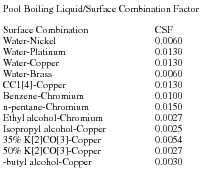 |
| 3 | = | S (liquid constant).
S[water] = 1.0
S[other liquids] = 1.7 |
| 4 | = | saturation temperature,  . |
MPID | 1 | = | liquid specific heat, c  |
| 2 | = | phase change enthalpy,  . |
| 3 | = | liquid absolute viscosity,  |
| 4 | = | liquid surface tension,  |
| 5 | = | liquid density,  |
| 6 | = | vapor density,  |
| 7 | = | liquid thermal conductivity kl |
Correlations for Configuration 24
| | Specific heat of liquid. |
| | Enthalpy of phase change. |
CSF | | Experimental constant (see Ref. 6 in Appendix A). |
| | Liquid viscosity. |
| | Surface tension at vapor-liquid interface. |
S | | Liquid constant; 1.0 for water; 1.7 for all other liquids. |
| | Saturation temperature. |
| | Wall temperature. |
Q | | |
DIFF | | |
Figure 9‑24
Configuration 25
Forced Convection Through Packed Beds
Node Number | 1 | = | bed temperature,  . |
| 2 | = | fluid entrance temperature,  . |
| 3 | = | fluid exit temperature,  . |
GP | 1 | = | bed surface area,  . |
| 2 | = | ratio of bed surface area to bed volume, A. |
| 3 | = | mass flux (mass flow/unit cross-sectional area of bed),  . |
| 4 | = | particle shape factor,  . |
MPID | 1 | = | fluid absolute viscosity,  . |
| 2 | = | fluid specific heat,  . |
| 3 | = | fluid thermal conductivity, k. |
Figure 9‑25
Correlations for Configuration 25
(Re < 50)
| | Fluid specific heat at bulk temperature. |
| | Mass flux rate. |
A | | ratio = surface area/volume of bed |
y | | Particle shape factor, as follows: 1.00 (spheres)
0.91 (cylinders)
0.86 (flakes)
0.79 (raschig rings)
0.67 (partition rings)
0.80 (berl saddles) |
| | Absolute viscosity at film temperature. |
Pr | | Prandtl number at film temperature. |
Re | | |
H | | |
Q | = | |
(Re > 50)
| | Fluid specific heat at bulk temperature. |
| | Mass flux rate. |
A | | ratio = surface area/volume of bed |
y | | Particle shape factor, as follows: 1.00 (spheres)
0.91 (cylinders)
0.86 (flakes)
0.79 (raschig rings)
0.67 (partition rings)
0.80 (berl saddles) |
| | Absolute viscosity at film temperature. |
Pr | | Prandtl number at film temperature. |
Re | | |
H | | |
Q | | |
Configuration 26
Generic Natural Convection, H=H(TDIFF)
Node Number | 1 | = | element surface temperature,  . |
| 2 | = | fluid temperature,  . |
GP | 1 | = | element’s surface area,  . |
| 2 | = | generic convection correlation coefficient, GP (2). |
| 3 | = | generic convection correlation exponent, GP (3). |
MPID | (Not used) |
Figure 9‑26
Correlations for Configuration 26
Correlation 54
Generic Natural Convection
Configuration 27
Generic Natural Convection, H=H(Gr, Pr)
Node Number | 1 | = | element surface temperature,  . |
| 2 | = | fluid temperature,  . |
GP | 1 | = | element’s surface area,  . |
| 2 | = | gravitational constant,  . |
| 3 | = | characteristic length,  . |
| 4 | = | coefficient for convective equation, GP (4). |
| 5 | = | Grashoff number exponent, GP (5). |
| 6 | = | Prandtl number exponent, GP (6). |
MPID | 1 | = | fluid density,  . |
| 2 | = | fluid absolute viscosity,  . |
| 3 | = | fluid coefficient of expansion,  . |
| 4 | = | fluid specific heat,  . |
| 5 | = | fluid thermal conductivity, k. |
Figure 9‑27
Correlations for Configuration 27
Correlation 55
Generic Natural Convection
Configuration 28
Generic Forced Convection
Node Number | 1 | = | element surface temperature,  . |
| 2 | = | fluid temperature,  . |
GP | 1 | = | element’s surface area,  . |
| 2 | = | characteristic length used for Reynolds number,  . |
| 3 | = | fluid free stream velocity,  . |
| 4 | = | coefficient for correlation, GP (4). |
| 5 | = | Prandtl number exponent, GP (5). |
| 6 | = | Reynolds number exponent, GP (6). |
MPID | 1 | = | fluid density,  . |
| 2 | = | fluid absolute viscosity,  . |
| 3 | = | fluid specific heat,  . |
| 4 | = | fluid thermal conductivity, k. |
Figure 9‑28
Correlations for Configuration 28
Correlation 56
Generic Forced Convection
Configuration 29
Generic H Value, H = H(TBAR) or H(time)
Node Number | 1 | = | element surface temperature,  . |
| 2 | = | fluid temperature,  . |
GP | 1 | = | element’s surface area,  . |
MPID | 1 | = | H value (entered as a material property). This value is evaluated as a function of the average of the two nodes' temperatures. If the MPID is flagged with time as the independent variable, it will be used instead of the average temperature. |
Figure 9‑29
Correlations for Configuration 29
Correlation 57
Generic H Value, H = H(tbar)
Configuration 30
Generic H Value, H = H(TDIFF)
Node Number | 1 | = | element surface temperature,  . |
| 2 | = | fluid temperature,  . |
GP | 1 | = | element’s surface area,  . |
MPID | 1 | = | H value (entered as a material property). This value is evaluated as a function of the absolute value of the temperature difference of the two nodal temperatures. |
Figure 9‑30
Correlations for Configuration 30
Correlation 58
Generic H Value, H = H(TDIFF)
Configuration 31
Constant H Value
Node Number | 1 | = | element surface temperature,  . |
| 2 | = | fluid temperature,  . |
GP | 1 | = | element’s surface area,  . |
| 2 | = | constant H value. |
MPID | (Not used) |
Figure 9‑31
Correlations for Configuration 31
Correlation 59
Generic Constant H Value
H = GP(2)
Configuration 32
Rotating Disk
Node Number | 1 | = | disk element surface temperature,  . |
| 2 | = | fluid temperature,  . |
GP | 1 | = | element’s surface area,  . |
| 2 | = | element’s resistor’s surface area inner radius. |
| 3 | = | element’s resistor’s surface area outer radius. |
MPID | 1 | = | fluid density,  . |
| 2 | = | fluid absolute viscosity,  . |
| 3 | = | fluid specific heat,  . |
| 4 | = | fluid thermal conductivity, k. |
| 5 | = | disk rotation speed, radians/time,  . |
Figure 9‑32
Correlations for Configuration 32
Correlation 60
Rotating Disk

(Reynolds Number)
Pr = Cp * μ/k (Prandtl Number)
Configuration 33
Forced Convection, Smooth Isothermal Tubes
Node Number | 1 | = | tube/element inside wall temperature,  . |
| 2 | = | fluid temperature,  . |
GP | 1 | = | tube/element’s inside surface area. |
| 2 | = | distance from upstream tube section to the tube inlet,  . |
| 3 | = | distance from downstream tube section to the tube inlet,  . |
| 4 | = | tube inner diameter,  . |
MPID | 1 | = | fluid density,  . |
| 2 | = | fluid absolute viscosity,  . |
| 3 | = | fluid specific heat,  . |
| 4 | = | fluid thermal conductivity, k. |
| 5 | = | average fluid velocity,  . |
Figure 9‑33
Note: | This configuration is identical to Configuration 1, 348 and its accompanying correlations, except that it requires only 2-noded resistors and uses DT instead of an LMTD. |
Configuration 34
Smooth Tubes, Constant Heat Flux, Turbulent Flow, Forced Convection
Node Number | 1 | = | tube/element inside wall temperature,  . |
| 2 | = | fluid temperature,  . |
GP | 1 | = | tube/element’s inside surface area,  . |
| 2 | = | distance from upstream tube section to the tube inlet,  . |
| 3 | = | distance from downstream tube section to the tube inlet,  . |
| 4 | = | tube inside diameter,  . |
MPID | 1 | = | fluid density,  . |
| 2 | = | fluid absolute viscosity,  . |
| 3 | = | fluid specific heat,  . |
| 4 | = | fluid thermal conductivity, k. |
| 5 | = | average fluid velocity,  . |
Figure 9‑34
Note: | This configuration is identical to Configuration 2, 352 and its accompanying correlations, except that it requires only 2-noded resistors and uses DT instead of an LMTD. |
Configuration 35
Combined Natural and Forced Convection in Horizontal Tubes
Node Number | 1 | = | tube inside wall temperature,  . |
| 2 | = | fluid temperature,  . |
GP | 1 | = | tube/element’s inside surface area,  . |
| 2 | = | distance from upstream tube section to the tube inlet,  . |
| 3 | = | distance from downstream tube section to the tube inlet,  . |
| 4 | = | gravitational constant,  . |
| 5 | = | tube inside diameter, D. |
MPID | 1 | = | fluid density,  . |
| 2 | = | fluid absolute viscosity,  . |
| 3 | = | fluid coefficient of thermal expansion,  . |
| 4 | = | fluid specific heat,  . |
| 5 | = | fluid thermal conductivity, k. |
| 6 | = | average fluid velocity,  . |
Figure 9‑35
Note: | This configuration is identical to Configuration 21, 399 and its accompanying correlations, except that it requires only 2-noded resistors and uses DT instead of an LMTD. |
Configuration 36
Forced Convection Through Packed Beds
Node Number | 1 | = | bed temperature,  . |
| 2 | = | fluid temperature,  . |
GP | 1 | = | bed surface area,  . |
| 2 | = | ratio of bed surface area to bed volume, A. |
| 3 | = | particle shape factor,  . |
MPID | 1 | = | fluid absolute viscosity,  . |
| 2 | = | fluid specific heat,  . |
| 3 | = | fluid thermal conductivity, k. |
| 4 | = | mass flux (mass flow/unit cross-sectional area of bed),  . |
Figure 9‑36
Note: | This configuration is identical to Configuration 25, 411 and its accompanying correlations, except that it requires only 2-noded resistors and uses DT instead of an LMTD. In addition, this configuration allows the mass flux to be a variable rather than a constant as is the case with Configuration 25, 411. |
Configuration 37
Contact Resistance with an Interstitial Fluid
Node Number | 1 | = | surface temperature of surface 1,  . |
| 2 | = | surface temperature of surface 2,  . |
GP | 1 | = | element’s surface area, A. |
| 2 | = | rms roughness (meters) of surface  ,  |
| 3 | = | rms roughness (meters) of surface  ,  |
| 4 | = | mean free path at 15  and 1 atm,  . |
| 5 | = | temperature jump ratio  |
| 6 | = | scale factor (usually 1.0), F. |
MPID | 1 | = | interstitial fluid thermal conductivity  |
| 2 | = | thermal conductivity surface #1  |
| 3 | = | thermal conductivity surface #2  |
| 4 | = | contact pressure (Pascals),  . |
| 5 | = | strength of surface #1 or surface #2, whichever is softest (Pascals),  . |
| 6 | = | fluid pressure, (Pascals),  . |
Correlations for Configuration 37
Correlation 61
Contact Resistance
Configuration 37 originally was based on Ref. 12 in Appendix A. With Version 8, the correlation has been redone based on the original work defined in Ref. 13 in Appendix A. The ability to input fluid pressure was added to the correlation.
This correlation which defined the total conductance between two surfaces is assumed to be the sum of two mutually independent conductances-the component through the interstitial fluid and that through the contacting area.
These are dependent on the contact area and equivalent fluid thicknesses which in correlation are correlated to fluid characteristics and material properties.
The fluid conductance is defined by its conductance and the fluid equivalent thickness.
where:
| | Fluid thermal conductivity. |
| | Equivalent fluid thickness. |
Data has been correlated over a wide range by the following expression:
where the dimensionless quantities are defined:
where:
| | the maximum distance between surfaces and as a first approximation can be taken as twice the mean roughness of each surface. |
| | |
l | | temperature jump distance and based on molecular-kinetic concepts and is defined: where a = accommodation coefficient and  = fluid molecules’ mean free path. |
It is often difficult to pinpoint a value for the accommodation coefficient and this reference provides a table for some gases. It should be noted that the mean free paths quoted in this reference are at best 50% higher than many other references, but are provided to be consistent with the reference the correlation was developed in.
Table 9‑2 oGas | a | | 2 l/  |
Air | 0.83 | 9.6 x 10-8 | 4.6 |
Hydrogen | 0.20 | 16.0 x 10-8 | 22.1 |
Helium | 0.38 | 28.5 x 10-8 | 14.8 |
Argon | 0.85 | 10.0 x 10-8 | 5.1 |
The mean free path is directly proportional to absolute temperature and inversely proportional to pressure. The corrections for actual conditions is adjusted with the following relation:
where all the reference values are related to 15

and 1 atmosphere. All fluid material properties are evaluated at the average temperature of the surface nodes. Appropriate adjustment in the temperature from the internal calculation units to units consistent with the correlation are done automatically; however, all quantities must be in SI units

= 288.15 K

= 101325 Pa
The second part of the conductance is that through the material which is in contact. This is dependent on the contact pressure and material strength to define the effective area of conductance. The correlation for this term is
P | | contact pressure, Pascals,  . |
| | strength of the softest material, Pascals,  . |
| | effective thermal conductivity of the material combination. |
| | |
This equation is valid for relative contact pressure to strength ratios in the order of 0.025 and temperatures below 0.3 of the fusion point. For higher or prolonged loads at elevated temperatures, creep must be considered which increases the interface conductance.
The coefficient C is a function of the rms roughness of each surface.
Note: | The 14.42 is an adjustment from what was defined in the reference in order to provide a continuous function. |
The final conductance involves a scale factor which can provide desired adjustments due to additional knowledge about the surfaces or for units adjustment because some aspects of the correlation are dependent on the SI unit’s system.
The resultant heat transfer is
where the area is equated based on the geometric node where the contact coupling is applied.
Configuration 38
Generic Forced Convection with Variable Velocity
Node Number | 1 | = | element surface temperature,  . |
| 2 | = | fluid temperature,  . |
GP | 1 | = | element’s surface area,  . |
| 2 | = | characteristic length used for Reynolds number,  . |
| 3 | = | fluid free stream velocity,  . |
| 4 | = | coefficient for correlation, GP (4). |
| 5 | = | Prandtl number exponent, GP (5). |
| 6 | = | Reynolds number exponent, GP (6). |
MPID | 1 | = | fluid density,  . |
| 2 | = | fluid absolute viscosity,  . |
| 3 | = | fluid specific heat,  . |
| 4 | = | fluid thermal conductivity, k. |
| 5 | = | fluid velocity, variable dependence. |
Figure 9‑37
Correlations for Configuration 38
Correlation 62
Generic Forced Convection with Variable Velocity
Fluid velocity is the product of GP(2) and MPID(5) evaluation. The independent variable for velocity evaluation is either the bulk fluid temperature or time.
H = k / Lc * GP(4) * PrGP(5) * ReGP(6)
Configuration 39
Generic H Value, H = H(Tb) * GP
Node Number | 1 | = | element surface temperature,  . |
| 2 | = | fluid temperature,  . |
GP | 1 | = | element’s surface area,  . |
| 2 | = | Heat Transfer Coefficient Scale factor. |
MPID | 1 | = | Heat Transfer Coefficient Variable Definition. |
Figure 9‑38
Correlations for Configuration 39
Correlation 63
Generic H Value, H = H(Tb) * GP(2)
Heat transfer coefficient is the product of GP(2) and MPID(1) evaluation. The independent variable for the variable evaluation is either the bulk fluid temperature or time.
H = H(Tb) * GP(2)
Configuration 40
Generic H Value, H = H(Tb) * GP - Ignore Area
Node Number | 1 | = | element surface temperature,  . |
| 2 | = | fluid temperature,  . |
GP | 1 | = | element’s surface area,  . |
| 2 | = | Heat Transfer Coefficient Scale factor. |
MPID | 1 | = | Heat Transfer Coefficient Variable Definition. |
Figure 9‑39
Correlations for Configuration 40
Correlation 63
Generic H Value, H = H(Tb) * GP(2)
Heat transfer coefficient is the product of GP(2) and MPID(1) evaluation. The independent variable for the variable evaluation is either the bulk fluid temperature or time. Although the surface area is defined, it is not used to determine the heat flux.
H = H(Tb) * GP(2)
Configuration 41
Generic Forced Convection with Viscosity Correction
Node Number | 1 | = | element surface temperature,  . |
| 2 | = | fluid temperature,  . |
GP | 1 | = | element’s surface area,  . |
| 2 | = | characteristic length used for Reynolds number,  . |
| 3 | = | fluid free stream velocity,  . |
| 4 | = | coefficient for correlation, GP (4). |
| 5 | = | Prandtl number exponent, GP (5). |
| 6 | = | Reynolds number exponent, GP (6). |
| 7 | = | Viscosity Exponent if heating fluid, GP(7). |
| 8 | = | Viscosity Exponent if cooling fluid, GP(8). |
MPID | 1 | = | fluid density,  . |
| 2 | = | fluid absolute viscosity,  . |
| 3 | = | fluid specific heat,  . |
| 4 | = | fluid thermal conductivity, k. |
| 5 | = | fluid velocity, variable dependence |
Figure 9‑40
Correlations for Configuration 41
Correlation 64
Generic Forced Convection with Viscosity Correction when Heating fluid.
Fluid velocity is the product of GP(2) and MPID(5) evaluation. The independent variable for velocity evaluation is either the bulk fluid temperature or time.
Correlation 65
Generic Forced Convection with Viscosity Correction when Cooling fluid.
Fluid velocity is the product of GP(2) and MPID(5) evaluation. The independent variable for velocity evaluation is either the bulk fluid temperature or time.
Configuration 42
Generic Forced Convection with Temperature Correction
Node Number | 1 | = | element surface temperature,  . |
| 2 | = | fluid temperature,  . |
GP | 1 | = | element’s surface area,  . |
| 2 | = | characteristic length used for Reynolds number,  . |
| 3 | = | fluid free stream velocity,  . |
| 4 | = | coefficient for correlation, GP (4). |
| 5 | = | Prandtl number exponent, GP (5). |
| 6 | = | Reynolds number exponent, GP (6). |
| 7 | = | Temperature Exponent if heating fluid, GP(7). |
| 8 | = | Temperature Exponent if cooling fluid, GP(8). |
MPID | 1 | = | fluid density,  . |
| 2 | = | fluid absolute viscosity,  . |
| 3 | = | fluid specific heat,  . |
| 4 | = | fluid thermal conductivity, k. |
| 5 | = | fluid velocity, variable dependence. |
Figure 9‑41
Correlations for Configuration 42
Correlation 66
Generic Forced Convection with Temperature Correction when Heating fluid.
Fluid velocity is the product of GP(2) and MPID(5) evaluation. The independent variable for velocity evaluation is either the bulk fluid temperature or time.
Correlation 67
Generic Forced Convection with Viscosity Correction when Cooling fluid.
Fluid velocity is the product of GP(2) and MPID(5) evaluation. The independent variable for velocity evaluation is either the bulk fluid temperature or time.
Configuration 43
Local Flat Plates, Forced Convection
Node Number | 1 | = | plate/element surface temperature,  . |
| 2 | = | free-stream fluid temperature,  . |
GP | 1 | = | plate/element surface area,  /element. |
| 2 | = | distance to the plate’s leading edge,  . |
| 3 | = | free-stream fluid velocity, x=L scale factor. |
MPID | 1 | = | fluid density,  . |
| 2 | = | fluid absolute viscosity,  . |
| 3 | = | fluid specific heat,  . |
| 4 | = | fluid thermal conductivity, k. |
| 5 | = | variable fluid velocity. |
Figure 9‑42
Velocity is the product of velocity scale factor and the variable velocity material property. All temperature dependent material properties are evaluated at the film temperature.
Correlations for Configuration 43
Local Flat Plate Forced Convection, Laminar Flow
Correlation 68 (Ref. 11 in Appendix A)
Correlation 69 (Ref. 11 in Appendix A)
Correlation 70 (Ref. 11 in Appendix A)
All other cases, but valid for
Local Flat Plate Forced Convection, Turbulent Flow
Correlation 71 (Ref. 11 in Appendix A)
Correlation 72 (Ref. 11 in Appendix A)
If Reynolds number between laminar and turbulent limits, a linear interpolation between the laminar and turbulent values is used.
Configurations 44-999
Reserved (not currently used)
These configuration numbers are reserved for future expansion of the QTRAN convection correlation library.
Configurations 1000+
User Supplied
These configuration numbers are reserved for User-Coded convection configurations that may be incorporated into subroutine UHVAL. The calling sequence for UHVAL is as follows:
SUBROUTINE UHVAL (ICFIG, IRESIS, COEFF, EXPO, MPID, GP,
T1, T2, GVALH, Q, LOGP, J1, J2, J3, J4, J6)
An example UHVAL subroutine is included in the QTRAN package with excellent internal documentation. Refer to it before attempting to write your own.
The arguments for UHVAL are defined as follows:
:
INTEGER | ICFIG, IRESIS, MPID, J1, J2, J3, J4, J6 |
LOGICAL | LOGP |
REAL*8 | COEFF, EXPO,GP, T1, T2, GVALH, Q |
Values Passed to the User
ICFIG | Configuration type (CFIG value). This value will always come to be as 1000 or greater. Use the ICFIG integer to choose between one or more of the convection configurations. |
IRESIS | The convective resistor number whose heat flow is being calculated. This integer is used to point into the correct row of the GP and MPID arrays. |
COEFF | Material Property Data. |
EXPO | Material Property Data. |
MPID | MPIDs assigned by the user to the convective resistor. |
GP | Geometric Property data assigned by the user to the convective resistor. |
T1 | Temperature of node 1. |
T2 | Temperature of node 2. |
LOGP | If LOGP = .TRUE., the routine is being called to dump any resistor data to the output file. |
J1-J4, J6 | Dimensions for the COEFF, EXPO, MPID and GP arrays. |
Values Passed by You, Required by QTRAN
GVALH | The “conductance” of the resistor, equal to the product of the h value and the resistor area. |
Q | Heat flow from node 1 to node 2 through the resistor. |










